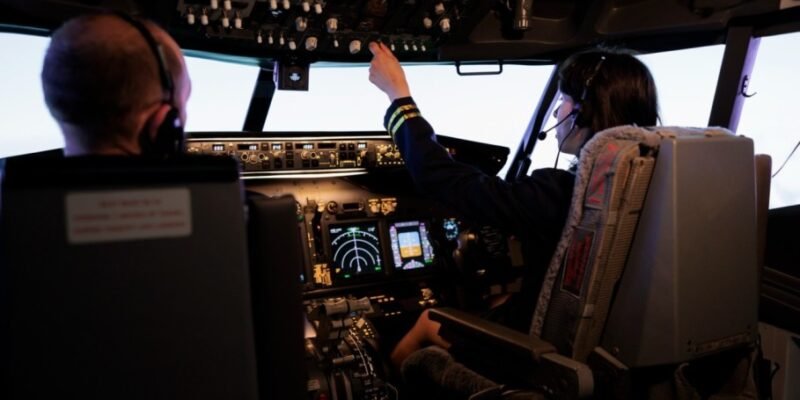
It’s a clear day with perfect flying conditions. The pilots of Flight 101 have begun their descent to LAX, preparing for landing. Suddenly, the plane veers off course, diving sharply as the pilots struggle to regain control. Alarms blare in the cockpit as the autopilot seems to take on a mind of its own. The plane narrowly misses colliding into a crowded terminal before the pilots can wrench back manual control and abort the landing.
This terrifying scenario may sound like the plot of a Hollywood thriller, but it’s exactly what could happen if hackers were to spoof GPS signals to sabotage modern aircraft. As airlines increasingly rely on GPS navigation, they may be charting a course for disaster.
Thesis
GPS has revolutionized aviation, enabling more efficient routes and automated landings. However, by broadcasting fake GPS signals, attackers can hijack these navigation systems, endangering planes. While solutions exist, airlines must make security a priority to avoid catastrophic incidents.
Background
The Global Positioning System (GPS) has become integral to air travel. Using signals from satellites, GPS units can pinpoint an aircraft’s precise real-time location and feed this data to the autopilot, allowing for more direct routing. This automation makes flying easier for pilots and allows airlines to serve more destinations.
Problem
However, academic researchers and cybersecurity experts have demonstrated the ability to “spoof” these GPS signals. By broadcasting false data, hackers can fool aircraft into believing they are in the wrong location. Even amateur hobbyists have used spoofing devices to divert the course of private planes. As airlines rely more heavily on automation, the risks posed by hacking will only increase.
Scope
This article will examine spoofing techniques, detail incidents of past airline interference, assess the risks, and review solutions aviation experts propose to secure systems. With collaboration and vigilance, the industry can stay on course to navigate the rising spoofing threat.
The Spoofing Threat
Types of GPS Spoofing
Hackers use a variety of strategies to override legitimate GPS data, each posing unique dangers. Common approaches include:
- Signal Jamming – By flooding an area with radio noise, jammers can block authentic GPS signals entirely. Aircraft are left flying blind, unable to receive any satellite data.
- Replay Attacks – In this technique, hackers record legitimate GPS signals, then rebroadcast them to trick systems. By replaying older data, they can transport an aircraft back in time to alter its course.
- Spoofing Generators – Portable devices mimic true GPS signals, but transmit false location data to deceive receivers. Modified signals can gradually or abruptly alter an aircraft’s perceived position.
Vulnerable Systems
Virtually every component of modern aircraft that utilizes GPS is vulnerable, including:
- Autopilot – Spoofed data will prompt the autopilot to steer the plane off course or dangerously alter altitude based on false positioning.
- Navigation – Aircraft may display incorrect bearings and locations, unaware they are being rerouted by fake signals.
- Landing Systems – Approaches and runway alignments rely on accurate GPS, leaving aircraft susceptible during descent.
Real-World Incidents
While spoofing has thus far caused only minor disturbances, its potential impact is impossible to ignore. Known aviation cases include:
- In June 2019, a suspected spoofing incident diverted multiple aircraft from Newark Liberty International Airport, forcing aborted landings.
- Researchers in 2018 successfully spoofed the GPS of a private drone, forcing it hundreds of meters off course without the pilot’s knowledge.
- The US Navy cruiser Antietam ran aground in January 2017 after its GPS system was mysteriously disrupted, possibly by Russian spoofing activity.
Potential Risks
- Hijacking – Hackers could redirect flights to enemy territory or unauthorized airports for malicious purposes.
- Collision – Spoofed planes risk crashing into terrain, structures, or other aircraft due to altered trajectories.
- Crash Landings – Aircraft relying on false altitude data may descend prematurely or aim for the wrong runway, endangering passengers.
“Spoofing represents a fundamental threat to safety in aviation,” warns GPS security expert Logan Scott. “Until we remedy these system weaknesses, hackers essentially have the ability to remotely hijack airplanes.”
Defending Against the Phantom Menace
Cybersecurity Measures
While no single solution can fully eliminate spoofing risks, aviation experts recommend implementing layered defenses:
- Spoofing Detection Algorithms – Analyze GPS signals to detect telltale signs of spoofing activity, triggering alerts.
- Encryption – Encode satellite signals using cryptography to prevent interception and modification.
- Signal Authentication – Verify GPS data is truly originating from designated satellites, ignoring fake sources.
- Redundant Navigation – Integrate additional navigational inputs like inertial measurement to provide backup.
“By combining these techniques, airlines can make it extremely difficult for hackers to successfully tamper with systems,” explains airline cybersecurity consultant Mariah Black.
Regulatory Considerations
Government oversight will also be critical to enforcing spoofing countermeasures:
- The FAA should mandate redundancies and spoofing detection for all safety-critical commercial aviation systems.
- International standards organizations must develop consistent cybersecurity protocols across national airlines.
- Lawmakers need to enact harsh criminal penalties to deter would-be aviation hackers and spoofers.
Pilot Training and Awareness
Even with safeguards in place, pilots must be prepared to take manual control if spoofing occurs:
- Training programs should incorporate simulated spoofing events to hone response reflexes.
- Cockpit displays could incorporate spoofing alert systems, warning pilots of ongoing attacks.
- Checklists should provide step-by-step guidance to regain navigation control and abort landings.
International Cooperation
With air travel spanning the globe, securing aircraft will require worldwide partnerships:
- Aviation bodies must share data on new spoofing threats as they emerge.
- Neighboring countries should cooperate to locate sources of spoofing and share expertise.
- Manufacturers must work to rapidly deploy patches and spoofing fixes across international fleets.
Future Technologies
Researchers are also pioneering navigation technologies inherently resilient against hacking:
- Quantum-encrypted GPS would utilize quantum data signals impossible to copy or spoof without detection.
- Satellite-independent navigation systems would navigate using only inertial, optical, and lidar data, avoiding GPS entirely.
By investing in these emerging solutions, airlines can chart the safest course forward.
Conclusion
GPS spoofing represents an imminent danger to airline safety. Early incidents already show hackers can tamper with navigation to endanger aircraft and passengers. As aviation grows more automated, these risks will only escalate.
Hope
For decades, GPS has guided aviation into an era of unprecedented safety and efficiency. While spoofing highlights vulnerabilities in these systems, it also presents an opportunity. With focus and persistence, the aviation industry can emerge more resilient. New navigation technologies and collaborative defenses will chart the safest path ahead.
Impression
Airlines now fly at the mercy of hackers exploiting GPS signals. To avoid disaster, cybersecurity must become as crucial as pilot safety. The time to act against this threat is now, before flights veer dangerously off course.













